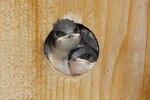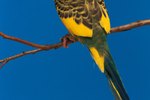Things You'll Need
Soap and water
Small margarine container
Tissue or toilet paper
Eyedropper
Sugar
Gooseneck lamp
Hummingbirds are the smallest of birds and are delicate creatures that rarely survive in captivity, especially baby hummingbirds that have fallen from the nest or are otherwise separated from their parents. There are ways to care for a baby hummingbird before transporting it to a wildlife expert. In the United States, it is illegal to have wild hummingbirds in your care without special permits.
Wash your hands. Always wash your hands with soap and water before handling a baby hummingbird.
Observe the baby hummingbird to determine its age. Hatchlings 0 to 9 days old are about the size of a raisin and have no feathers. A hatchling will be blue-gray in color and its eyes will be closed. Nesting hummingbirds are between 10 and 15 days old and will have tiny pin feathers that resemble porcupine quills. Fledgling hummingbirds are between 16 and 21 days old. They are fully feathered, but will have short tail feathers and a bill less than a ½-inch long.
Line a small margarine container with tissue or toilet paper and place the baby bird in the container. Hatchlings are not able to regulate their body temperature, so place a gooseneck lamp with the bulb about 5 inches above the bird container. You will need to keep a hatchling warm at approximately 85 to 90 degrees Fahrenheit (29 to 32 degrees Celsius). Do not place bulb too close to the baby bird or allow temperature to rise above 90 degrees Fahrenheit (32 degrees Celsius) or you will kill the hatchling.
Feed nesting and fledgling hummingbirds. Mix a solution of 1 tsp. sugar to 4 tsp. of water. Use a small eyedropper with sugar water solution and gently coax the bird’s bill into the dropper. Do not squeeze the sugar water into the bird’s bill or you might drown it. If the bird is drinking the solution you will see its tongue moving into the liquid. Wipe off any sugar water that gets on the bird’s feathers immediately. Sugar water can be offered every 30 minutes until you can get the bird to a wildlife center. Do not feed nesting and fledgling hummingbirds the nectar solution for more than 24 hours. Do not attempt to feed hatchling hummingbirds, just keep them warm and transport to a wildlife care facility immediately.
Transport the baby hummingbird to a local wildlife rehabilitation center for care as soon as possible.
Warnings
Hummingbirds require a highly specialized diet and you should not attempt to care for a baby hummingbird for more than 24 hours at home.




